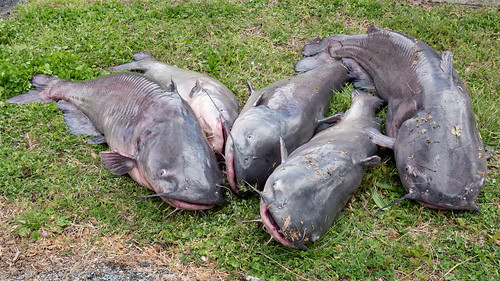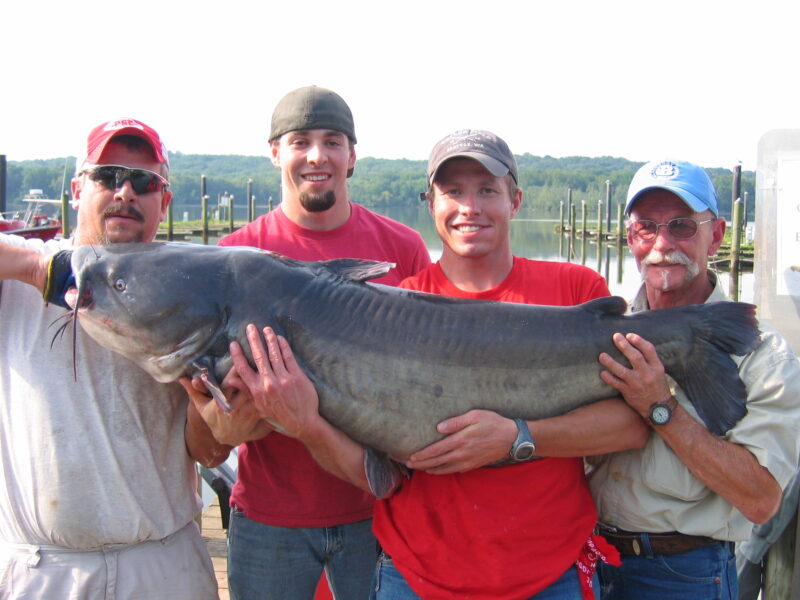
Some of the 2,000 pounds of blue catfish caught at the Sharptown Catfish Tournament in 2022. Such tournaments are becoming a popular way to target the species. Maryland Department of Natural Resources photo.
Article by A.J. Metcalf, Director of Communications for the Maryland Department of Natural Resources – The invasive fish has spread throughout Maryland in recent years, but the record held by an Oregon man still stands
Ed Jones, an Oregon resident, said he’ll never forget the day he caught the Maryland state record blue catfish. It was also the day he lost his phone.
“I can remember it as vividly as the day is long,” Jones said in March while recounting the fateful August 2012 catch. “I hooked him, was reeling him in, and as soon as we got him near the boat, I had my cell phone in my shirt pocket, leaned over the boat, and plunk. It fell right into the river. I had all these pictures [on the phone] and I lost them in the river.”
However, he still has at least one picture from that day. It’s a picture of him, his son, and others holding up the giant blue catfish he caught. That fish, at 84.0 pounds, still holds the Maryland blue catfish state record to this day.
“I’ve had the picture posted on the wall in my garage forever,” said Jones. He added that the plaque given to him by the Maryland Department of Natural Resources for breaking the state record also hangs in his home, “I’ve got it hung up where anybody that comes to my house can see it.”
Jones’ blue catfish state record is one that the Department of Natural Resources is hoping anglers will try to break–and in the process of attempting to do so, help the overall ecosystem by removing large blue catfish from the water.
Blue catfish are an increasingly harmful and overly plentiful invasive species in the Chesapeake Bay ecosystem. The non-native catfish species were first introduced in Virginia in the 1970s to create a new sport fishery. During the previous decade, blue catfish have been spreading northward into a majority of Maryland’s tributary rivers that flow into the Chesapeake Bay, according to tracking data collected by Department of Natural Resources scientists. The commercial blue catfish harvest has increased in the state from 609,525 pounds in 2013 to 4.2 million pounds in 2023, more than a 500% increase in the past decade.
Blue catfish are voracious predators that eat significant amounts of commercially important native species such as blue crabs, menhaden, and white perch. As the catfish grow in size, they must eat more food to maintain their weight, making them more harmful to the broader ecosystem. Larger female blue catfish also produce significantly more offspring, compounding the problem. This is why the Department of Natural Resources is urging anglers that catch these large fish to remove them from the water. There are no seasons nor fishing limits for blue catfish.
”Big blue catfish have eaten a lot of our native and important species to reach those sizes, and bigger fish produce more offspring,” said Branson Williams, the invasive species program manager for the department. “We know some anglers are throwing these big catfish back to catch them again and protect the population. Unfortunately, for all the other species in the Bay that are eaten by these fish, the catch-and-release blue catfish anglers are making the problem worse by not removing the invasive fish.”
Williams believes a new state record blue catfish is currently swimming somewhere in Maryland waters. The current Virginia state record, which is also the world record for blue catfish, stands at 143 pounds. It was caught in Buggs Island Lake, near the North Carolina border, in 2011.
Blue catfish in Maryland provide food for anglers, school and state programs, and the fish now exported as a high quality protein beyond our state borders. While not everyone may want to clean and eat blue catfish filets, anglers can also cut the fish up and use the meat as crab bait or for chumming when fishing.
Other ideas include growing better gardens with composted blue catfish or helping people eat by donating blue catfish to friends, families, or food banks.
While the department strongly discourages catch and release fishing for blue catfish, it is not illegal to do so. However, it is illegal in Maryland to release a live blue catfish into a different body of water than where it was originally captured. Anyone in violation of this can be fined up to $2,500 per incident.
And if an angler catches a blue catfish that’s potentially a new state record, please call the Department of Natural Resources at 443-569-1398 to report the catch.
All state record fish must be evaluated and identified by a fisheries biologist to claim the record. In order to qualify for any of the three invasive species records, including the blue catfish record, the fish must be removed from the water and killed.
For anglers interested in tournament competition, this year more than a dozen blue catfish fishing tournaments are scheduled around Maryland. Most of the tournaments include a largest blue catfish competition–an opportunity for an angler to break the state record–as well as a category to see who can catch the most blue catfish in a certain time period.
If you do break the record, you’ll receive a plaque and a picture commemorating your achievement, just like Ed Jones did back in 2012. And by not returning these large blue catfish to the water, even when they don’t break the state record, you’ll be reducing the harm caused to the ecosystem by blue catfish.

Ed Jones, right, poses with his son, a friend, and a charter guide while holding the Maryland state record blue catfish in 2012.


